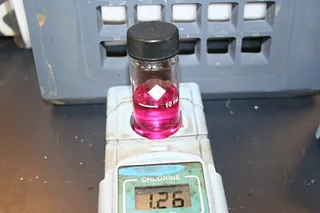A partial re-post from a similar discussion that took place in the past here on MFK….
I think that this hobby can be a simple, or as complicated, as one wants to make it. I recall looking after a friends fish room while he was away in Singapore on a fish buying trip. He handed me 2 fricken pages of instructions & things that I needed to check each day! LOL But he had some incredible fish, probably 20K worth of Asian aro alone, along with thousands of dollars’ worth of black rays, and various other not so easy to find fish. His fish room was crazy over engineered, and super impressive by design, and he was smart enough to pull it all off & make it run like a Swiss watch. Myself, I could never build a fish room like that, I just don't have the know how or smarts in that area. I understand my limitations. Asking me to design and build a fish room like his would be like asking me to design & build a 3 story home.
I’m a simple guy which is why I tend to apply the KISS (keep it simple stupid) method to fish keeping as much as possible. I also like to add a layer of redundancy where I can, more than 1 filter (in case filter fails), more than 1 heater (at lower wattage so as not to cook fish if/when a thermostat sticks ON) , everything plugged into a GFCI power bar or receptacle, or dedicated GFCI breaker - with a grounding probe in each tank. NOT that I would EVER suggest to others to do this with their bio-media, and their tanks, but ....... I clean my sponges, and finer filter media directly under the tap with 2 ppm chloramine. I understand that I am killing off a percentage of bio-bacteria while doing this, but I honestly don't care if the bacteria is almost completely wiped clean each time that I do this, because I have a large bag of very well established (20+ yrs established) sintered glass bio-media in each filter that I protect like the crown jewels. Each tank contains 3 large bags of well-seasoned bio-media.
Those bio-media bags get a light swish in a bucket filled with clean, dechlorinated with Seachem Safe, tap water. I also clean ALL filters at the same time, on the same day, in each tank. Again, this is what I do, with my filters, and my tanks, and my species of fish, because I know exactly what I am doing. I would never recommend this to others. Way too many variables involved to second guess someone else's set up from afar.
One of my large bio-media bags is enough to kick start a 100 gallon tank, instantly. Just add water & fish. I would NEVER clean that media anywhere near ANYTHING that could even remotely be considered toxic. I too have learned my fair share of lessons, the hard way.
Now if I had a 0.1 ppm chlorine residual coming out of my tap, I wouldn't be the least bit worried about dechlorinator, and would probably do exactly like Ted Judy, or at the very most use a weak sodium thiosulfate solution for water changes, and for cleaning media. I don't have plants to help remove free ammonia (NH3) which is also very toxic to fish, so I use a water conditioner that can render NH3 safe for fish (Seachem Safe), because with each water change with chloramine, once the chlorine/ammonia bond is split, free ammonia is left behind. Free ammonia is like second hand smoke, even a little causes harm, and can have a cumulative effect. I think that this hobby can be a simple, or as complicated, as one wants to make it.
If someone feels that the chlorine and/or chloramine coming out of their taps won't cause any issues in their set ups, or their bio-media, then by all means go for it.
I also do massive water changes in the 80-90% range, and I have high pH, and at the higher pH values free ammonia becomes a lot more toxic to fish. Add higher temps to that equation and things become even more deadly, if one isn't careful. I hesitate to even mention how large of water changes I do, so as not to influence someone that keeps more sensitive species, or doesn't understand their own personal limitations, like I do. I have kept species of fish in the past where 30% water changes were pretty much the breaking point for their stress level, so that's as high as I went.
This is why is it so important to for each & every hobbyist to understand their limitations, with their set ups, and their fish, and then live by those limitations.




